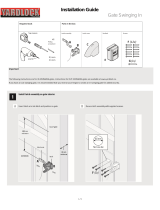EDR4 1200 04/03
11
Receiver setup
Mode jumper
This jumper must be removed. If it is not removed then the remote control will only operate
the gate once for every two button presses. This jumper enables the latching output on the
receiver card.
Learning remotes
The receiver can learn up to 20 remotes. After 20 remotes, the 20th will be overwritten.
Only one button per remote can operate the receiver.
To learn a remote, press and hold the LEARN button until the receiver status LED goes out.
Press the desired button on the remote control and hold till the status LED flickers. Press it
again to confirm.
Remote Transmitter Learning (RTL)
This option allows a user to add remotes without accessing the receiver card.
It does not allow the deletion of remotes. After 20 remotes, the 20th will be over-written.
If RTL is enabled the receiver status LED will double-flash in the standby state. If RTL is
disabled the receiver status LED will single-flash in the standby state.
To change state, hold the LEARN button down for three seconds as the power is reset.
Check the receiver status LED flashes to confirm the state change.
Merlin recommends enabling this option. Check for a double-flash on the receiver status
LED at standby.
Deleting remotes
All remotes can be deleted by pressing and holding the LEARN button for 11 seconds, until
the receiver status LED stops fast-flashing. This resets the receiver back to its default
settings. Check you still have the desired RTL state.
Common Access installations
To allow unlimited numbers of common access users, the M832C or M834C remote con-
trols are required. These have a DIP switch code block that sets a fixed code for the main
button on the M832C or on two buttons of the four on the M834C. The remaining buttons
are high-security code-hopping.
The M834C is useful for separate entry and exit gates.
Common access remotes are only available in the full-sized remote controls.
Adding an external antenna
Only connect a Merlin M001 external antenna with MCX co-axial connector to the receiver
card. This antenna, cable and connector is tuned to give the best performance.
Before attaching the co-axial connector, snip the simple wire antenna from the receiver
card so that only one antenna is active.
The ground plane of the M001 greatly improves the antenna’s performance. An alternative
is to mount the antenna through a metal plate that is at least as large as the ground plane’s
length. For optimum performance any ground plane should make good electrical contact
with the metal boss of the M001 antenna.
Contact Merlin for M002 (10m) or M003 (3m) antenna extension cables if additional dis-
tance is required between the controller and the antenna.

















